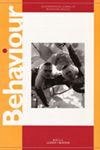Moving vs still prey: do common wall lizards show any preference?
IF 1.2
4区 生物学
Q4 BEHAVIORAL SCIENCES
引用次数: 0
Abstract
Among prey functional traits, mobility plays a major role, affecting its actual availability to predators: a moving animal is usually more susceptible of being detected than immobile or inanimate prey. With the aim of investigating the role played by visual cues and preference for moving vs. immobile prey in a widespread, generalist species, common wall lizard Podarcis muralis, we used two different experimental approaches. First, we assessed the preference of tested individuals for either one active or one still mealworm (Tenebrio molitor), symmetrically hung in a T-shaped arena (single prey preference experiment); secondly, each individual was left free to interact for 20 min with two closed boxes containing 10 moving or still worms, kept at opposite sides of a rectangular arena (multiple prey experiment). Our results showed that lizards consistently selected the moving stimuli when no chemical prey-borne cues were available. When choosing between single prey, we found inter-individual variation in both lizard preference for moving or still prey and latency to attack, which may depend on either microhabitat-related difference in foraging tactics or personality traits.移动与静止的猎物:普通壁蜥是否有偏好?
在猎物的功能特征中,移动性起着重要作用,它影响着猎物对捕食者的实际可用性:移动的动物通常比不动或无生命的猎物更容易被发现。为了研究视觉线索在一种广泛分布的通食物种--普通壁蜥 Podarcis muralis 中的作用以及对移动猎物与不动猎物的偏好,我们采用了两种不同的实验方法。首先,我们评估了受试个体对对称悬挂在T形竞技场中的一条活动或静止黄粉虫(Tenebrio molitor)的偏好(单个猎物偏好实验);其次,让每个受试个体在20分钟内自由地与长方形竞技场相对两侧的两个装有10条活动或静止黄粉虫的封闭盒子进行互动(多个猎物实验)。实验结果表明,在没有猎物化学线索的情况下,蜥蜴会一致选择移动的刺激物。在选择单一猎物时,我们发现蜥蜴对运动或静止猎物的偏好以及攻击潜伏期都存在个体间差异,这可能取决于与微生境相关的觅食策略差异或个性特征。
本文章由计算机程序翻译,如有差异,请以英文原文为准。
求助全文
约1分钟内获得全文
求助全文
来源期刊

Behaviour
生物-动物学
CiteScore
1.80
自引率
7.70%
发文量
44
审稿时长
3 months
期刊介绍:
Behaviour is interested in all aspects of animal (including human) behaviour, from ecology and physiology to learning, cognition, and neuroscience. Evolutionary approaches, which concern themselves with the advantages of behaviour or capacities for the organism and its reproduction, receive much attention both at a theoretical level and as it relates to specific behavior.
 求助内容:
求助内容: 应助结果提醒方式:
应助结果提醒方式:


